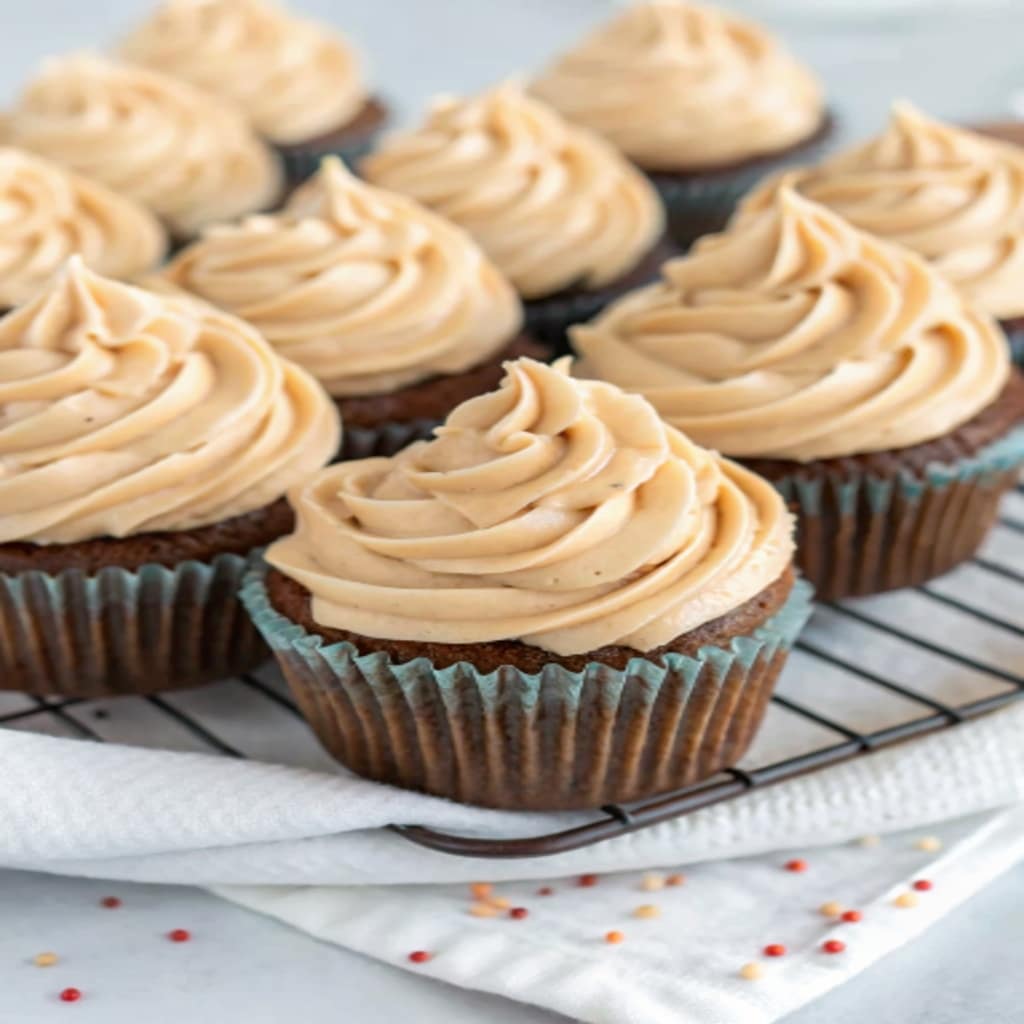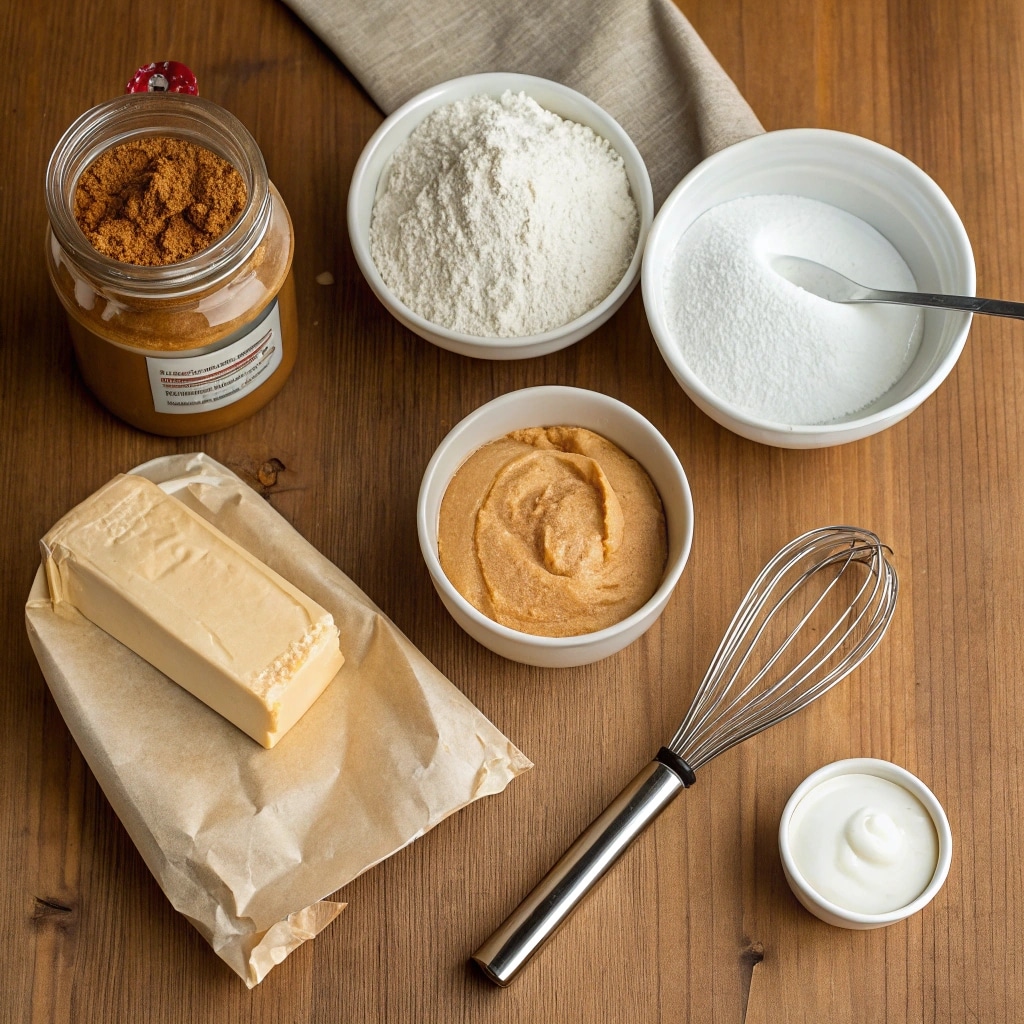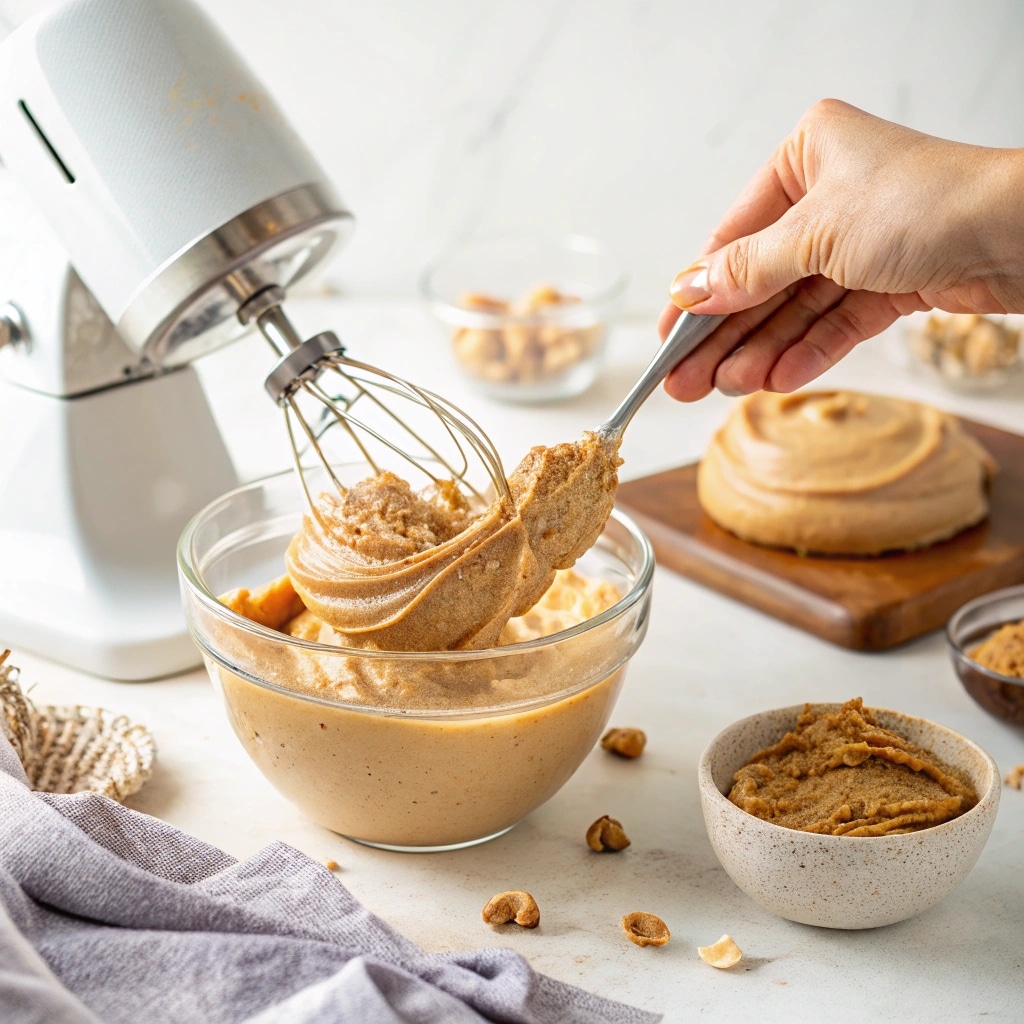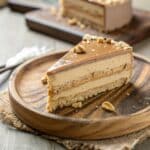I still remember the first time I tasted a slice of cake filled with peanut butter cream cake filling—it was like discovering the sweetest secret hiding between two layers of sponge. I was baking with my grandma in Asheville, making biscuits, and she joked about turning any dessert into something magical with peanut butter. That memory sparked my love for creating dreamy fillings that elevate every bite.
In this guide, you’ll learn why peanut butter cream cake filling is a game‑changer in baking, what ingredients give it the perfect texture and flavor, and how to whip it up step by step. We’ll explore delightful variations, pairing ideas, and storage tips so you can feel confident using this silky filling in cakes, cupcakes, or even as a dip. Let’s dive in and bake something beautiful together!

Table of Contents
Introduction to Peanut Butter Cream Cake Filling
What Is Peanut Butter Cream Cake Filling?
Peanut butter cream cake filling is that dreamy, silky-smooth spread nestled between cake layers—richer than whipped frosting, yet light enough to melt in your mouth. It’s made by blending creamy peanut butter, powdered sugar, and butter, often with a splash of cream or milk for smoothness. Unlike standard frosting, this filling isn’t just for looks—it’s for flavor and moisture that transforms an ordinary cake into something seriously indulgent. Whether you’re layering it between chocolate sponge or pairing it with banana cake, it offers a nutty depth that satisfies in every bite.
Why It’s a Game-Changer in Baking
This filling isn’t just delicious—it’s versatile. You can whip it up soft and airy or make it thick and rich for cupcakes or sandwich cookies. It pipes beautifully, spreads easily, and pairs well with almost any cake flavor. From birthday cakes to elegant dinner desserts, it adds a nostalgic, cozy flavor that feels homemade and heartfelt. I use it often in my peanut butter-based bakes, like the peanut butter and banana rice cakes, where that smooth, nutty richness plays perfectly with soft textures. Add it between your cake layers, and you’ll turn a simple dessert into something guests talk about long after the last bite.
Ingredients That Make the Perfect Peanut Butter Cream Filling
Core Ingredients for Peanut Butter Cream Cake Filling
The heart of a great peanut butter cream cake filling is all about balance—smooth texture, rich flavor, and just enough sweetness to let the peanut butter shine. Here’s what you’ll need to make a classic version:
Ingredients:
- 1 cup creamy peanut butter (like Skippy or Jif—not natural)
- ½ cup unsalted butter, softened to room temperature
- 1½ to 2 cups powdered sugar, sifted
- 2–4 tablespoons heavy cream or milk, to adjust consistency
- (Optional) ¼ teaspoon fine sea salt, to enhance flavor
- (Optional) 2 oz cream cheese, for tang and structure

You’ll use these basics to create a filling that’s sturdy enough for cake layers, but still soft and smooth on the palate. I love using this combo in my peanut butter and jam cake, where the creamy richness of the filling complements the fruity sweetness. It also stars in layered bakes like the peanut butter chocolate cake cheesecake, giving contrast and depth between chocolate layers.
Why Creamy Peanut Butter Matters (Skippy vs. Natural)
This is where many bakers go wrong: choosing natural peanut butter. Even though it’s great for toast, it tends to separate and creates a gritty or oily filling. For cake, you need a stable, emulsified spread—Skippy or Jif are ideal because they keep the texture consistent.
The difference? Regular peanut butter holds its form when whipped and mixed, while natural versions often break down. You want a creamy peanut butter cake filling that layers smoothly and won’t make your cake soggy or greasy after sitting.
If you’re going dairy-free, use a stabilized nut butter (like creamy almond or sunflower) that mimics traditional peanut butter’s smooth, dense texture.
Step-by-Step Peanut Butter Cream Cake Filling Preparation
Making a peanut butter cream cake filling is easier than most frostings—and just as rewarding. Here’s the classic method I use in my kitchen at Sweet Magnolia:
- Start by beating the butter: In a large bowl, beat ½ cup unsalted butter until smooth and pale. This step is key—it creates the airy base.
- Add the peanut butter: Mix in 1 cup of creamy peanut butter (Skippy works great). Beat for 1–2 minutes until fully combined and fluffy.
- Incorporate powdered sugar: Gradually add 1½–2 cups of sifted powdered sugar. Mix on low first to avoid a sugar storm, then crank it up to medium-high.
- Add cream or milk: Pour in 2–4 tablespoons of heavy cream or milk, one at a time, until your filling is spreadable but not runny.
- Final whip: Beat for another minute to get that smooth, cloud-like texture.

You’ll end up with a spread that’s rich but light—ideal for filling cakes or even piping into cupcakes.
Print
Peanut Butter Cream Cake Filling
- Total Time: 10 min
- Yield: 2 cups 1x
- Diet: Vegetarian
Description
This peanut butter cream cake filling is rich, fluffy, and versatile—perfect for cakes, cupcakes, and sandwich cookies.
Ingredients
1 cup creamy peanut butter (Skippy or Jif)
½ cup unsalted butter, softened
1½–2 cups powdered sugar, sifted
2–4 tbsp heavy cream or milk
(Optional) ¼ tsp sea salt
(Optional) 2 oz cream cheese
Instructions
1. Beat the butter until smooth and fluffy.
2. Add peanut butter and mix until fully combined.
3. Gradually add powdered sugar on low speed.
4. Add cream 1 tablespoon at a time until desired consistency is reached.
5. Optional: mix in cream cheese or salt for added flavor.
6. Whip once more until light and smooth.
Notes
Store in the fridge for up to 5 days.
Freezes well for up to 2 months.
Great for cupcakes, cakes, and sandwich cookies.
- Prep Time: 10 min
- Cook Time: 0 min
- Category: Cake Fillings
- Method: No-Bake
- Cuisine: American
Nutrition
- Serving Size: 2 tbsp
- Calories: 145
- Sugar: 11g
- Sodium: 110mg
- Fat: 11g
- Saturated Fat: 3.5g
- Unsaturated Fat: 6.5g
- Trans Fat: 0g
- Carbohydrates: 12g
- Fiber: 1g
- Protein: 3g
- Cholesterol: 10mg
Variations of Peanut Butter Cream Cake Filling
Chocolate Peanut Butter Cream Filling
Chocolate and peanut butter are a flavor match made in dessert heaven. To turn your base peanut butter cream cake filling into a chocolate lover’s dream, just add ½ cup of cocoa powder or melted semi-sweet chocolate to the original recipe. Blend it in with the butter and peanut butter stage to ensure full incorporation.
For a richer twist, some bakers also stir in a tablespoon of chocolate hazelnut spread. The result? A creamy, stabilized peanut butter cream with a deep cocoa undertone that’s perfect for chocolate or vanilla cake layers. I love using this in cupcakes too—it pairs beautifully with chocolate ganache or a drizzle of caramel.
Vegan & Dairy-Free Alternatives
Making a dairy-free peanut butter filling is easier than you’d think. Swap out the butter for a plant-based margarine (like Earth Balance) and replace heavy cream with oat milk, almond milk, or full-fat coconut milk. You’ll still get a creamy, spreadable texture—just be sure your peanut butter is also dairy-free (some flavored versions contain milk solids).
For a firmer vegan filling, add ½ tablespoon of cornstarch dissolved in warm plant milk before mixing. Chill the final filling for 15–20 minutes before using. It pipes well and sets up beautifully between sponge layers.
This dairy-free version is excellent for warmer days or when serving guests with dietary needs. It’s also the base I use for my peanut butter filling in non-bake desserts like eclairs and layered trifles.
Best Cakes That Pair with Peanut Butter Cream Cake Filling
Ideal Cake Types: Chocolate, Banana, Vanilla & More
Peanut butter cream cake filling shines best when paired with cakes that either contrast its richness or echo its cozy flavor. Here are the top matches:
- Chocolate cake: The deep cocoa notes make a bold pairing with sweet, nutty filling. Think of it like a grown-up Reese’s—this combo is always a hit at birthdays and holidays.
- Banana cake: A surprisingly delightful match. The creamy filling plays off the soft, fruity sponge, as seen in my peanut butter and banana rice cakes.
- Vanilla or yellow cake: A classic base that lets the peanut butter cream cake filling take center stage.
- Peanut butter cake: For peanut butter superfans, doubling down creates a unified flavor with layers of buttery goodness. Try a variation like the one in our peanut butter and jam cake for a nostalgic twist.
These pairings work beautifully for both sheet cakes and layer cakes. Just make sure to balance sweetness—if your sponge is super sweet, consider reducing the powdered sugar in your filling.
Layering Techniques That Maximize Flavor
Here’s how to get the most out of your peanut butter cream cake filling:
- Use a border method: Pipe a ring of thick frosting or stiffer filling around the cake edge, then spread the softer filling inside. This keeps it from oozing out.
- Chill between layers: After adding each layer of filling, chill the cake for 10–15 minutes before stacking the next. This prevents sliding and makes frosting easier.
- Balance textures: Add a thin layer of jam, ganache, or even crushed nuts between the filling and cake to give contrast and structure.
With the right combo of flavors and techniques, you’ll create a cake that’s visually stunning and absolutely irresistible.
Storing and Freezing Peanut Butter Cream Cake Filling
How to Store for Freshness
To keep your peanut butter cream cake filling fresh, store it in an airtight container in the refrigerator. It’ll stay good for up to 5 days if kept cold and sealed. Before using, let it sit at room temperature for 15–30 minutes to soften slightly. This helps restore that smooth, spreadable consistency.
If you’ve already filled your cake, no worries—just keep the whole cake covered and chilled. The filling helps retain moisture, especially when layered between denser cakes like chocolate or banana.
Don’t forget: if your filling contains cream cheese or dairy-based milk, refrigeration is non-negotiable for food safety. I always make my fillings the night before and let them rest overnight. This not only saves time but also helps deepen the flavor.
Can You Freeze It? Best Practices Explained
Yes, you can freeze peanut butter cream cake filling—but with care. Here’s how:
- Scoop into a freezer-safe container or resealable bag. Flatten it slightly to freeze faster and thaw evenly.
- Label it with the date. It’ll stay fresh for up to 2 months.
- Thaw overnight in the fridge when ready to use.
- Re-whip if needed after thawing. A quick mix will bring back the original texture.
This trick comes in handy when prepping for big events or batch baking. I’ve frozen leftover filling from my peanut butter chocolate cake cheesecake, and it thawed perfectly for cupcake fillings later.
Just remember: never refreeze a filling that’s already been thawed and left out. Always err on the side of freshness to maintain flavor and texture.
Common Mistakes to Avoid
Overbeating the Filling
It’s tempting to keep whipping your peanut butter cream cake filling to make it extra fluffy—but stop once it looks smooth and spreadable. Overbeating can introduce too much air, making the texture unstable or grainy. This becomes especially problematic when layering cakes, as the filling might deflate or even cause sliding between tiers.
Instead, beat the butter and peanut butter just until light and creamy, then mix in the sugar and cream slowly. If you’re using a stand mixer, switch to low speed when finishing to avoid over-aerating the mixture. I’ve learned this the hard way during summer weddings where fillings melted faster because they were too whipped.
Using the Wrong Peanut Butter
This is the mistake I see most often: choosing natural peanut butter. While natural options are great for toast, they aren’t ideal for fillings. They separate too easily and lead to oily or gritty textures.
Stick with classic creamy peanut butter brands like Skippy or Jif for the most reliable results. They include stabilizers that keep the texture smooth, even after whipping or chilling. If you’re working with a dietary restriction, opt for a dairy-free version that mimics the consistency of conventional creamy peanut butter.
Also, avoid using chunky or flavored varieties—they’ll affect both the structure and the overall taste. Save those for garnishes or toppings, not the filling itself.
FAQs: Peanut Butter Cream Cake Filling
What is the difference between peanut butter frosting and peanut butter cream cake filling?
Peanut butter frosting is typically stiffer and used to coat the outside of cakes or cupcakes, while peanut butter cream cake filling is softer and made to spread between layers. Filling usually has a slightly higher cream-to-sugar ratio to make it more spreadable and moist inside the cake.
Can I use natural peanut butter in cake fillings?
It’s not recommended. Natural peanut butter tends to separate and create oily or gritty textures. For best results, use stabilized creamy peanut butter like Skippy or Jif, which helps maintain a smooth, uniform consistency in your filling.
Is peanut butter cream filling stable for layer cakes?
Yes, as long as it’s made with the right ratio of butter to peanut butter and not over-whipped. If you’re stacking multiple layers or adding decorations, chill the cake after filling each layer to ensure structure and prevent sliding.
How do I make a dairy-free peanut butter cake filling?
Use a plant-based margarine in place of butter and substitute the heavy cream with oat milk, almond milk, or coconut milk. For added structure, mix in a bit of cornstarch dissolved in warm plant milk. Chill before using for best results.
Can peanut butter filling be frozen and reused?
Absolutely. Store it in an airtight container for up to 2 months. Thaw in the refrigerator overnight, then beat briefly to restore texture before using again.
What desserts pair best with peanut butter cream cake filling?
Chocolate cake is the top match, followed by banana and vanilla. It also works beautifully in cupcakes, sandwich cookies, and eclairs. You can even turn it into a dip or layer it in trifles.
Conclusion
Baking with peanut butter cream cake filling is like giving your dessert a cozy, flavorful hug. Whether you’re layering it into a chocolate birthday cake or spooning it into cupcakes for a surprise center, this filling never fails to impress. It’s creamy, nostalgic, and endlessly adaptable—from dairy-free swaps to chocolate-infused versions.
I hope this guide inspires you to try it in new ways—maybe even experiment with a few flavor boosters like espresso or maple. And if you’re just starting your baking journey, don’t worry. I’ve been there, too—messy kitchen, uncertain measurements, but full of excitement. You’ve got this.
If you haven’t yet, check out my full how to bake a cake tutorial for more tips on layering, crumb-coating, and making each bake a celebration.
Want more sweet inspiration? Follow me on Facebook and Pinterest where I share cozy, easy-to-make baking recipes just like this one. Every bite is a warm hug. Let’s bake something beautiful together.
